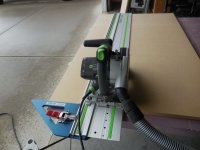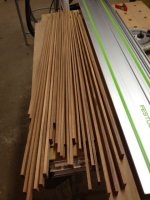The price of entry determines your market. You are going to appeal to tradesman and hobbyists with disposable income. Both of them are going to value time as much or more than money. People who value the money in their pockets more than their time are unlikely to appreciate any of the merits of these systems. They will argue that they can do the same things for less money with all sorts of work-arounds. You will be able to tell who these people are within two minutes of talking with them, and the best approach for both of you will be to acknowledge their point and disengage from the conversation.
If you think you've got the right audience for your product, then I got sold on the TS55 because I could break down sheet goods fast and straight with a minimal amount of set-up or time. I am a hobbyist with money, but not time. These systems allow me to get the most out of my shop time by saving me set-up and clean-up time, and that is well worth the cost to me.
If you think you've got the right audience for your product, then I got sold on the TS55 because I could break down sheet goods fast and straight with a minimal amount of set-up or time. I am a hobbyist with money, but not time. These systems allow me to get the most out of my shop time by saving me set-up and clean-up time, and that is well worth the cost to me.


